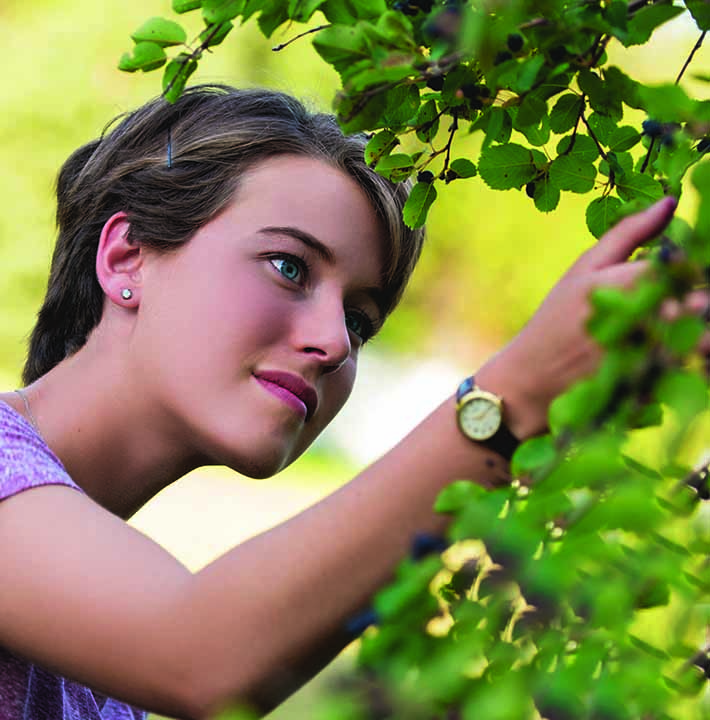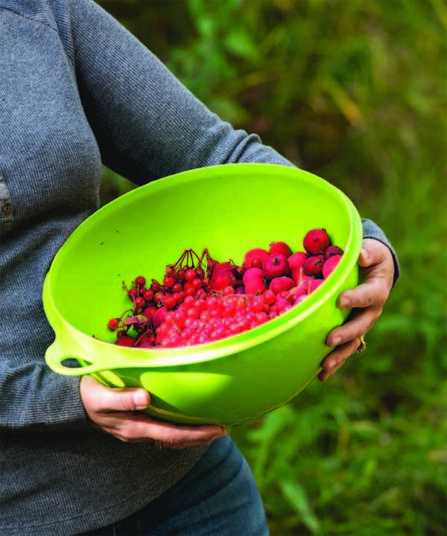Urban Foraging

A growing movement toward wild-harvested food has no trouble seeing the forest for the trees.
“Production right now is relatively minor, but in two or three years we’re going to start seeing our first flush of fruit,” remarks Kenton Zerbin, permaculture teacher and consultant. Zerbin is referring to the St. Albert Community Food Forest, the first of its kind in town.
Together with local urban agriculture enthusiasts, Zerbin designed this site using permaculture techniques, an approach to growing food that mimics the design of natural ecosystems for self-sufficiency. He estimates that in five-to-seven years the forest will reach its capacity, offering a safe nutritious source of edibles such as plums, red currants, gooseberries, haskap berries, saskatoons, comfrey, and more. And lots of it—free for whoever wants it.
Ripe for the Picking
Food forestry and permaculture might be unfamiliar concepts to many, but they’re part of a growing realization that cities are chock full of potential when it comes to food. It’s literally all around us—in city parks, in the woods, alongside rivers and roadways. Numerous books detail the variety of edible fruit, plant, and mushroom species available in Central Alberta—much of it on public land, available to anyone with a bucket and a little know-how.

The appeal of urban foraging is understandable, as any trip to the grocery store will uncover. Healthy food ain’t cheap. In 2013, the Edmonton Community Foundation reported that food costs had risen by more than double the overall inflation rate over the past 10 years. Food prices are notoriously volatile—in 2018 the Edmonton Food Bank distributed more than $22,000,000 worth of food.
A World of Foraging Possibilities
On paper, it seems there’s little stopping us from getting out there and taking advantage of the cornucopia of produce growing wild all around us, but obstacles exist. The first is knowing where to look. Cue the Internet, where maps have been popping up pinpointing precise locations of fruit trees and other edible plants around the world.
The biggest roadblock, however, is probably time and energy. Supermarket produce might be pricer, but it’s easy, and this is the likely cause of why so much backyard fruit goes to waste. Considering that an average apple tree can produce more than 100 kg of apples in a year, for some households even a single tree can be too much. And when you consider how many trees a city may have, both public and private, this adds up to a staggering amount of food that’s, unfortunately, for the birds.
Locally, Operation Fruit Rescue Edmonton (OFRE) musters volunteers to harvest backyard trees of homeowners unable to use their fruit. The haul from each pick is divvied up, with roughly a quarter each going to the homeowner, the volunteers, OFRE, and a charity such as the Food Bank or Hope Mission.
Reshaping Cities and Attitudes
In Edmonton, a food forest has sprung up in the MacKinnon Ravine, just west of downtown. The MacKinnon Food Forest began in 2014 as part of Root for Trees, an initiative by the City to plant trees, with a minimum target of 16,000 a year in order to increase Edmonton’s canopy cover from 10 to 20 percent.

The MacKinnon Food Forest bears highbush cranberries, currants, beaked hazelnuts, saskatoons, chokecherries, pin cherries, raspberries, elderberries, and strawberries. All are native plants, as designer Dustin Bajer points out.
“That was one of the ways we were able to do something like this,” Bajer says. “I don’t think the City would’ve been onboard had it been non-native species.”
Building a Food Forest 101
Permaculture aims to re-create ecosystems that not only produce food, but are also self-sustaining. Fortunately, Mother Nature gives us a pretty good model to riff on. Forests are made up of layers, from the canopy and understory to the ground cover and roots—and each has a function.
Canopies provide shade and protection so lower plants can thrive; meanwhile, perennials in the herbaceous layer die each year, feeding essential nutrients back into the soil. It’s this interplay between layers that makes a forest more than the sum of its parts, and it’s an incredibly efficient and resilient system that sustains many species of plants and animals in a small area.
As such, a good food forest design optimizes available sunlight, water, and soil through the careful arrangement of elements. Beyond that, the forest is more or less left to its own devices.
More Like This
Backyard Home Theatre
Read
Edmonton From Above
Read
‘Motoring’ around Edmonton
Read





